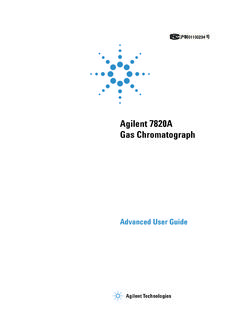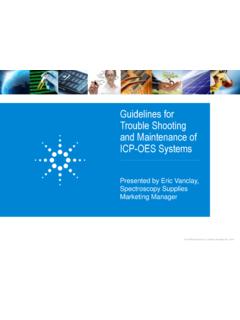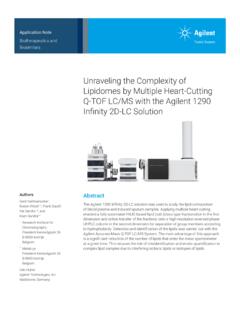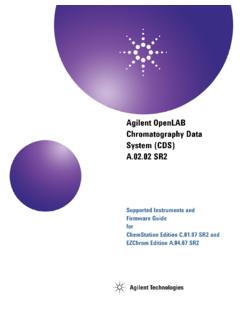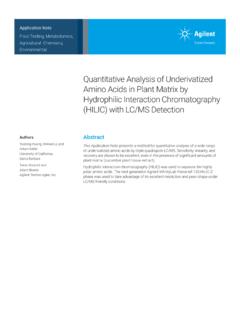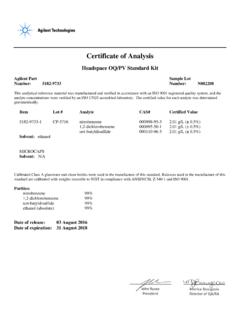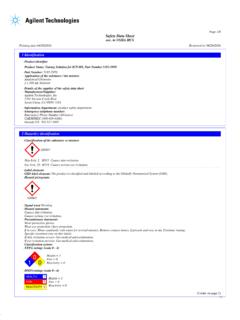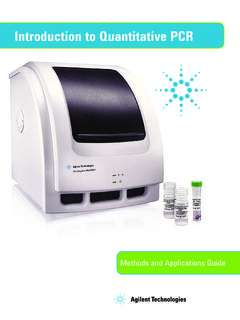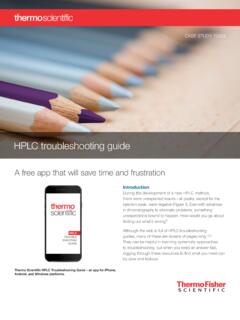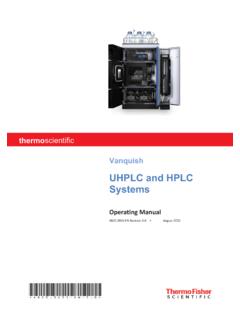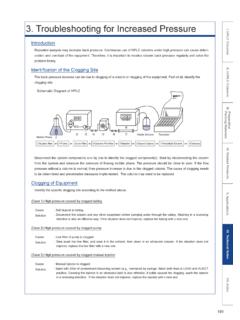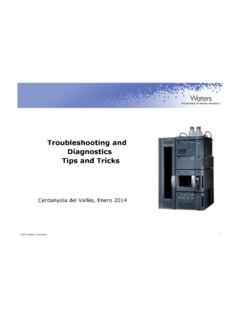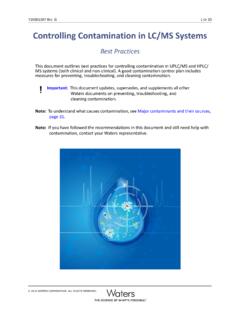Transcription of HPLC User Maintenance & Troubleshooting - Agilent
1 hplc User Maintenance & Troubleshooting Lori Sandford Applications Chemist Agilent Technologies Schaumburg, IL Physics Chemistry Hardware Application Chromatography Delay volume Fittings Column volume Stainless steel or Titanium Glass versus Stainless Frits Mobile phase pH Sample Prep Mobile phase UV cutoff Sample UV Maximun Data Sampling Type of Mixing Column Pressure What are Chromatographers Looking for? Best performance Resolution Highest throughput Reproducibility Accuracy of results Sensitivity Standard, narrow bore and capillary column capability N = Number of theoretical.
2 Plates Column length, particle size = Selectivity Stationary and mobile phase, temperature k = Retention Stationary and mobile phase Resolution Page 6 Know your hplc System: Pump Autosampler Column Comp. Detector Vacuum Degasser (integrated in Infinity II and Quat systems) Page 7 Know Your hplc Flow Path: Where are the moving parts? Where can blockages to flow occur? Where are the consumables that need to be replaced on a regular basis (PM)? Where can leaks occur ? What can I do to eliminate, reduce or anticipate potential problems with the LC ?
3 1290 Infinity Binary Pump the flow path Jet weaver Flow path in binary pump Channel A same for channel x pressure sensor Primary pump head starts at PIV Secondary pump head starts at OV Both tested flow paths end inside the purge valve rotor seal heat exch. filter assembly purge valve waste inlet, to SSV/degasser/bottle Flow path in quaternary pump pressure sensor multi- purpose valve Jet Weaver (opt.) inlet weaver MCGV to degasser x inline filter Primary pump head starts at PIV Secondary pump head starts at OV Both tested flow paths end inside the valve rotor seal Page 11 Agilent 1200 Series Pump Models - Analytical Isocratic Pump Quaternary Pump Std Binary Pump Page 12 Pump Head Main Components Plunger housing Pump head Outlet ball valve Active inlet valve Purge valve Page 13 Pump and Degasser Maintenance Clean the degasser lines by flushing with isopropanol.
4 When using buffers, flush with water, then with isopropanol. Check for air bubbles in outlet lines. Be aware of the possibility of microbial growth in aqueous phases. Check for solvent compatibility. Unused channels should be left in isopropanol. May have need to exchange the vacuum pump, sensor, solenoid valve, or vacuum chamber. Page 14 Overall Routine Pump Maintenance and disassemble the pump head. and clean pistons. piston seals. seal wash option is installed, replace wash seals and gaskets.
5 5. Inspect the springs. pump head and reinstall. seal wear-in procedure. PTFE frit in the purge valve. or replace the outlet ball valve. the AIV cartridge. 11. Flush with isopropanol. or replace solvent inlet filters. the leak sensor. certain the waste tube is in place. the pump (Pressure and Leak Test). - Covered by an annual Agilent LC PM contract When to use purge, prime, condition ? Purge Change solvents When pump is refilled with new/different mobile phase the purge valves allows both pump heads (binary pump) to be connected to waste at the same time Prime When the pump is dry When Purge and Condition still show exhausted pressure ripple Condition When first starting up for the day or after changing solvents When pump pressure ripple or composition ripple is too high (mixing noise) air bubble is hidden in pump head (listen)
6 Best once a day to condition for smooth operation Confidentiality Label October 15, 2015 15 Filters and Bottle necks for blockages Solvent inlet filters in solvent bottles glass: 20um replace if needed! SST: 12-14um replace, opt sonicate Inlet weaver (mixer) between MCGV & prim head (quat only) Heat exchanger (bent? Connection?) High pressure filter assemblies at outlet of secondary pump heads: 5um replace (see cleaning procedure) Quaternary pump: inline filter at multiple purpose valve MPV: replace Jet weaver (optional with 35um, 100ul, 380ul) Troubleshoot: Disconnect other modules behind pump Flow path before pressure sensor is uncontrolled !
7 Confidentiality Label October 15, 2015 18 Examples: used / unused Filters Glass filters: 3150 - 0944 Stainless Steel Filters: 01018 60025 (less volume, no Na+ ions) Confidentiality Label October 15, 2015 19 Example: Jet Weaver & Inlet Weaver Multi-layer technology Diffusion bonded stainless steel, etched structures Two mixers in one cartridge Standard mixer with 35 l volume & 100ul adds delay volume of 45ul and 75ul Optional mixer in quat pump with V380 which adds 150ul delay volume Mixer for TFA applications with adds 380 l volume delay volume 1290 Infinity Liquid Chromatograph Agilent Restricted April 6th.
8 2009 Page 20 Considerations for hplc systems Gradient Delay or Dwell Volume Beginning of Mixing End of Mixing The volume between the point of mixing of solvents (usually in the mixing chamber or at the proportioning valves in the liquid chromatograph) and the head of an LC column. Extracolumn Volume The volume between the effective injection point and the effective detection point, excluding the part of the column containing the stationary phase. It comprises the volumes of the injector, connecting lines and frits, and the detector.
9 It determines the extracolumn effects. System Signal height System dispersion Dispersion is the sample bandspreading or dilution which occurs in connecting tubing, sample valves, flow cells and in column end-fittings. Capillaries (Inner diameter, length) Dispersion Peak height: Loss of sensitivity Peak width: Loss of resolution Aris-Taylor Equation mDLFr 2442 Page 22 System Signal Height min 1 2 mAU 0 100 200 350 400 550 600 System dispersion optimized Peak width min Peak width min Resolution min 1 2 mAU 0 100 200 300 400 System dispersion not optimized Peak width min Peak width min Resolution 310 mAU 380 mAU Influence post-column capillary connections min 0 mAU 0 20 40 60 80 100 120 140 One bad capillary connection!
10 Min 0 mAU 0 30 60 90 120 150 180 210 Fixed! 130 mAU 160 mAU Page 26 System Signal height System volumes Delay volume Delay volume ~ 700 L min 1 2 3 4 mAU 0 100 200 300 400 Delay volume ~ 120 L min 1 2 3 4 mAU 0 100 200 300 400 Column: ZORBAX SB-C18 x 50 mm, m Flow: mL/min 120 mAU 220 mAU Delay volume Impact of low delay volume Page 28 Programmed gradient step Delay volume Low delay volume High delay volume time response What happens with a programmed gradient?
